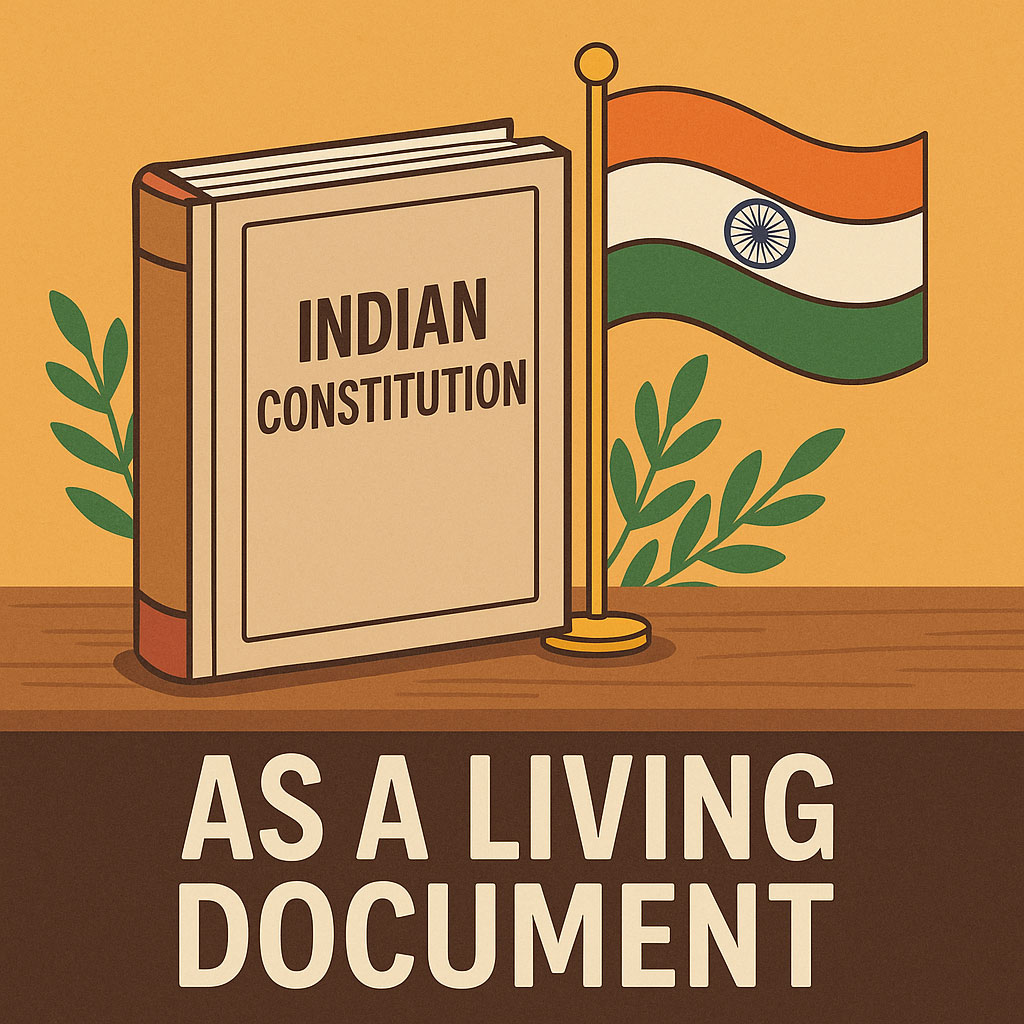If the Indian Constitution were a person, it would definitely be the cool grandparent — wise, experienced, but still trendy enough to understand Instagram reels, AI, and cyber laws.
Why? Because unlike a rigid old rulebook gathering dust on a shelf, our Constitution changes, adapts, and grows. It truly lives.
Let’s dive into why the Constitution of India isn’t just a legal document — it’s a lively, evolving companion that walks with society through every stage of its journey.
🌱 What Does “Living Document” Even Mean?
In simple words:
A living document is one that changes with time — not like your school timetable, but more like your phone’s software updates. 🔄
Justice Oliver Holmes once said, “The life of the law has not been logic; it has been experience.”
And the Indian Constitution is the perfect example — always learning, always adapting.
👶➡️👨🦳 From 1950 to 2025 — A Journey of Evolution
When our Constitution came into force in 1950, India was a newly independent nation with big dreams and even bigger challenges. But did the framers think India would one day deal with cyber-crimes, same-sex marriage debates, and data privacy issues? Probably not.
Yet the Constitution still works beautifully.
Why? Because it allows amendments, judicial interpretation, and flexible governance.
Some cool examples:
- 🧒 Right to Education (RTE) was added in 2002
- 🔐 Right to Privacy became a fundamental right in 2017
- 🏳️🌈 Section 377 overturned in 2018
- 🗳️ Voting age lowered from 21 to 18
- 👩⚖️ Basic Structure Doctrine ensures Parliament can’t just rewrite the Constitution casually
Each of these shows the Constitution’s ability to evolve with changing social values.
⚖️ The Judiciary: The Constitution’s Personal Trainer
If the Constitution is a living being, then the Supreme Court is its yoga coach, helping it stay flexible by interpreting it progressively.
Some epic cases that shaped India:
🔹 Kesavananda Bharati (1973)
The Court said: “Change is fine, but don’t mess with the soul of the Constitution!”
This gave birth to the Basic Structure Doctrine.
🔹 Maneka Gandhi Case (1978)
Turned Article 21 (right to life) into a powerhouse of rights — dignity, fairness, liberty, due process… basically the whole buffet.
🔹 Puttaswamy Case (2017)
Declared Right to Privacy a fundamental right — crucial in today’s digital age.
🔹 Navtej Singh Johar (2018)
Decriminalized same-sex relationships. A landmark in equality and dignity.
These judgments show how the Constitution adapts without changing its core values.
🧬 Why Do We Call It a Living Document?
Because it…
✓ Grows with society
From zamindari abolition to AI ethics, it covers everything.
✓ Balances stability & change
You can’t change it casually — but you can when needed.
✓ Responds to people’s aspirations
Social justice, human rights, equality — the Constitution keeps evolving to reflect modern India.
✓ Stays relevant across generations
Your grandfather’s India and your India may be different, but the Constitution works for both.
💬 A Beautiful Thought
Granville Austin, a noted historian, called the Indian Constitution
“a seamless web of principles — of social revolution and of unity and integrity.”
Even today, that web keeps expanding, stretching, and strengthening — just like a living organism.
🎉 Conclusion: The Constitution Isn’t Just Alive — It’s Thriving
The Indian Constitution is not a museum artifact. It is a dynamic, adaptable, ever-evolving guide that grows with us.
It protects our rights, balances power, corrects injustices, and supports new social realities — from gender identity to digital freedom.
A document that continues to learn is truly alive.
And that’s why the Indian Constitution remains one of the most respected, admired, and resilient constitutions in the world. 🌏✨

Leave a Reply